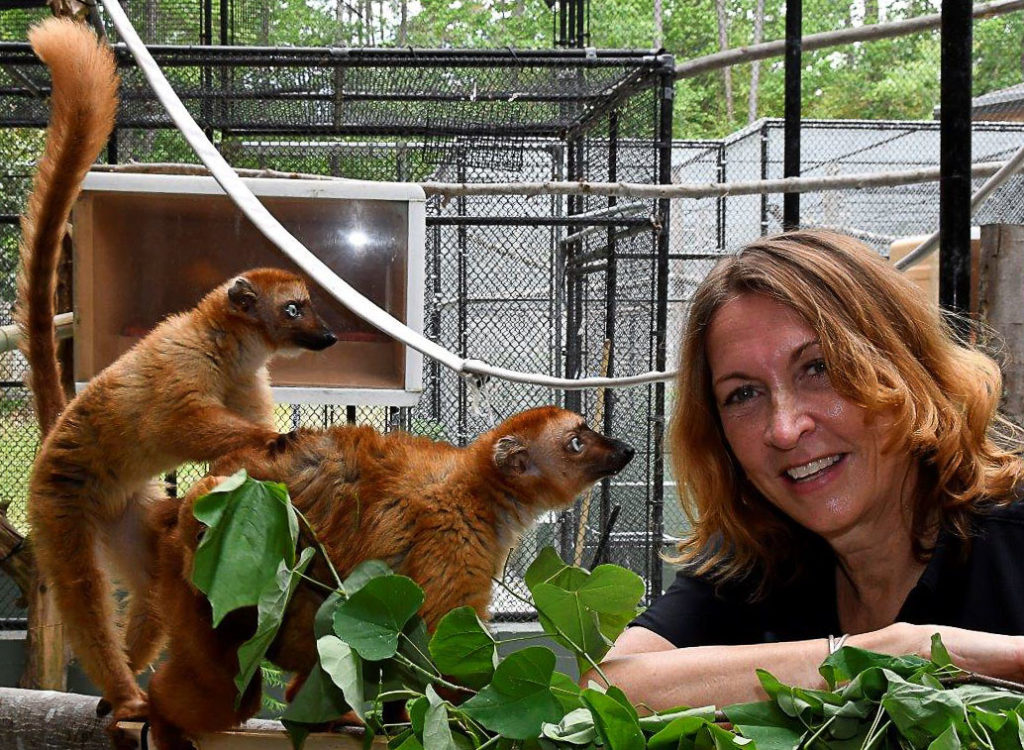
DLC Director Anne Yoder with blue-eyed black lemurs McKinnon and Wiig.
Dear Friend of the Duke Lemur Center,
I write to you with both a joyous “welcome to the world!” and a bittersweet farewell. On July 1st, I will be stepping down from the directorship of the Duke Lemur Center after nearly 13 years at its helm. It has been a marvelous time in my life, one that I will always treasure. You have been our partners throughout, and together we have accomplished amazing things. Thanks in good measure to your support, the DLC is a place transformed, and I hope that you, like I, will continue to hold it dear in your heart and continue to support the center as it moves ever more boldly into the future.
When I began my directorship in 2006, though the animal-care staff was (and remains) the most dedicated and talented group of people that I have ever known, conditions were far from ideal. The lemurs were housed in cages covered in plastic during the winter, with hot air pumped in to keep them warm. Our guest services consisted of a tiny gift shop and two porta-potties. We had no research department, no communications strategy, and no conservation programs in Madagascar. We had a veterinary staff of only one, and students were nowhere to be seen. The list of “didn’t haves” goes on and on.
It’s a dramatically different place now. We have two glorious new buildings that allow the lemurs to come and go in the woods during warm weather, no matter the time of year, and to be cozy and warm inside when it is cold. We have an inviting gift shop with modern facilities, a beautiful tour path, a tours and education team, a research department of four, a communications director, a development officer, a data manager, a colony curator, and a finely-tuned veterinary department consisting of two full-time vets and two full-time vet techs. We have record numbers of visitors, and the place is crawling with students ranging from kindergartners to graduate students. And fundamentally, our SAVA Conservation Initiative is doing critically important work in Madagascar. When I began my directorship, my son was a kindergartener—and this fall, he heads off to college. I think that you will agree that together, you and I have been on a long, wonderful ride!
Now the time has come for new leadership to step into the director’s role with fresh ideas and energy to carry the DLC yet further toward international impact in this critical time of decreasing support for the sciences and increasing threats to global biodiversity and the natural environment. For me, it is time to return to the professoriate and my research program, and none too soon—science waits for no (wo)man! Provost Sally Kornbluth will be launching a national search for my replacement while my partner in DLC leadership, Greg Dye, the Director of Operations and Administration, serves as interim director. It is an exciting time of optimism and opportunity, and the DLC’s future is brighter than ever.
But what about the joyous welcome that I promised above? Herewith, you are the first to know something that will on Monday be announced to the world: On April 12, 2018, the first baby born to the male and female blue-eyed black lemurs imported last year from Madagascar—the first lemurs to come to the DLC from Madagascar since 1993—entered the world. It was a dramatic birth, performed by C-section, but the outcome has been perfect. Our new arrival is a healthy baby girl, and we have named her Ranomasina—the Malagasy word for “sea.” Her eyes are bright blue, just like her namesake, and her parents’ voyage and success as a family mark a new day of hope and optimism for the health and security of lemurs here in Durham, and also, we trust, in Madagascar. None of this would have been possible without your support, and all of us at the DLC are eternally grateful.
When I assumed the directorship, all these years ago, two of my top goals were to see babies being born at the center after a nearly decade-long drought, and to once again import animals from Madagascar to stabilize genetic variation in the colony. Ranomasina is the realization of both of these dreams, and embodied in the most beautiful little creature you have ever seen. Thus, I conclude by bidding you a fond “au revoir” and join you in a raucous “welcome to the world!” for the precious and lovely Ranomasina.
Gratefully,
Anne
<><><><><><><><><><><><><><><>
Anne D. Yoder
Braxton Craven Professor of Evolutionary Biology
Director, Duke Lemur Center
<><><><><><><><><><><><><><><>

